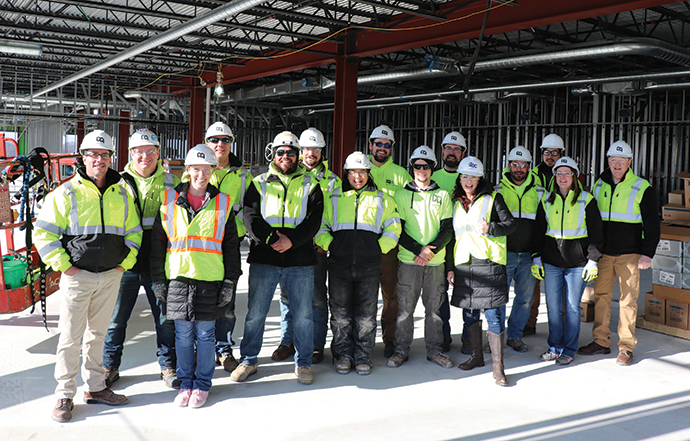When the rapid spread of COVID-19 shut down job sites all across the U.S. in March, one industry that kept on operating, if not always at full speed, was construction.
Deemed an essential business by most mayors and governors, construction continued even as more Americans came down sick with the disease and ended up in hospitals. Still, the construction industry was not immune to the effects of the pandemic-induced recession.

By April, construction employment declines had been registered in 326 of the nation’s 358 metro areas. An analysis by the Associated General Contractors of America (AGC) showed that construction employment had increased from March to April in only 20 metro areas, while industry employment was unchanged in 14 others. Over the previous 30 years, according to AGC, 75% of metro areas added construction jobs from March to April, on average, while just 12% of metros lost jobs. (AGC numbers released just this week point to a slight upsurge.)
In Wisconsin, the situation was better. Gov. Tony Evers’ “Safer at Home” order allowed most construction projects to continue during the social distancing mandates, even as work activity slowed at many job sites. AGC of Wisconsin reported that 44% of contractors surveyed said they had laid off field workers while 22% said they had to let office staff go.
By May, however, construction employment began showing signs of rebounding around the country. According to the Center for Economic and Policy Research, construction showed strong job growth in May, adding 464,000 jobs from April. Even with the uptick, employment nationwide in construction was down 5.8% in May from the previous year.
“We will see some sort of economic realignment. People will make career choices based on what they see as sustainable industries.”
To get a better handle on how Wisconsin was coping with the economic impact of the pandemic, we turned to Rebecca Kleefisch, Jobs Ambassador for Associated Builders & Contractors of Wisconsin (ABC). No stranger to economic development, Kleefisch served as lieutenant governor alongside previous Wisconsin Gov. Scott Walker from 2011 to 2019. In her new role, she serves as chief spokesperson for ABC while getting involved in workforce development for the construction trades in her home state.
How has the pandemic affected the construction industry and skilled trades in Wisconsin?
KLEEFISCH: Interestingly enough, it has not impacted the construction industry here all that much. Very early, the construction industry was ruled essential by our state government. That indicates there will be very few changes dictated by government. We need to have clean water, sanitation, electricity, etc. This requires construction workers. I interviewed an apprentice the other day. He said his daily life had changed very little. ABC very quickly adapted to the environment and switched to a learning technology that works for everyone.
What has ABC of Wisconsin had to do in response to the pandemic and recession?
KLEEFISCH: Our folks were on the phone with our technical trainers to determine how we could continue with no stoppage and no blockage in our pipeline. They shifted quickly to online learning models.
How has the pandemic affected worker training in the skilled trades and construction?
KLEEFISCH: In Wisconsin, our apprenticeships work with classroom training. That is 10% of their learning. The other 90% is on-the-job training. They are paid to go to work and learn under instructors and colleagues. They learn the teamwork experience and the skills experience. Because construction was ruled an essential industry, that part did not miss a beat. They continued to get up and go to job sites.
Are you seeing rising unemployment rates in various construction and trade jobs? Which jobs have been hit the hardest?
KLEEFISCH: We have not seen the impact in those jobs. This industry is not just surviving; it is thriving during this time. Our economists expect a work surge going into the fall. We continue to gear up for a normal apprenticeship season. Two factors are driving this. One is demographics. Baby boomers will continue to retire from this industry, so we need more apprentices. Secondly, there are still companies that have not fully recovered from the last recession at the end of the last decade. A lot of companies either closed or went down to such low capacity that it was very challenging for the industry to ramp up. Many of these companies still need to hire more workers to recover. Many were still in recovery mode from the last recession. We believe there will be continued work and even a surge in the fall.
What relief has the state of Wisconsin been able to provide to employers and workers?
KLEEFISCH: Most is a flow-through of aid from the federal government. They have been allocated to our small business owners and unemployed workers. Payroll Protection Program assistance came from the federal government and is being administered through many banks. That has been quite successful. The problem early on was people literally making a run on the bank. They did the second issuance of the PPP dollars. More changes came out recently. Not every dollar would have to go to payroll. Federal government now better understands what small businesses need. We have seen soaring unemployment rates in Wisconsin. We will see some sort of economic realignment. People will make career choices based on what they see as sustainable industries.
Are there any additional relief measures you would like to see implemented at either the federal or state level?
KLEEFISCH: The federal level got the message that the PPP was cumbersome. Not everyone can justify bringing workers back now. We are seeing people listening in D.C. I would like to see some changes in our unemployment system in Wisconsin. I hope that this changes soon. Expanded hours are allowable now. When you have a surge in capacity, taking on a contractor is a good idea. I see friends and neighbors who are unemployed and hurting. I see people every day who are unable to connect with an unemployment check. They cannot go on even days without it. It is a tragic number. The sooner we can get back to America working, the better off we will be. Almost immediately, we moved to virtual learning. We also saw the on-the-job protocols change as well. Now there are additional safety measures. There are temperature checks before workers are allowed on site. Portable toilets are changing. We have tool sanitation stations. More hand sanitizer is on site now. For everyone to feel safe, we have to take safety precautions.
How long do you think it will take Wisconsin’s economy to fully recover from this unprecedented setback?
KLEEFISCH: It depends on how quickly we are able to safely reopen and what is actually left of industries that have been gutted by this pandemic and the resulting decisions to protect people. Everyone has a different opinion about whether these lingering decisions are necessary to protect people or whether they are resulting in continuing destruction. These are all very real health-care issues as well — suicide, etc. We have to reduce unemployment, increase mental health, and ultimately move the state forward. Hopefully, this makes us more resilient and better prepared for another pandemic in the future.
What will happen to state and local governments when the second wave of decreased tax collections hit later this year?
KLEEFISCH: Governments will need to make even deeper cuts than they already have, and they cannot expect a federal bailout of bankrupt states and cities. The U.S. cannot afford to become a junk bond nation.

